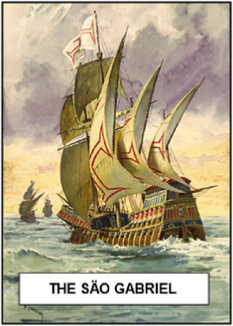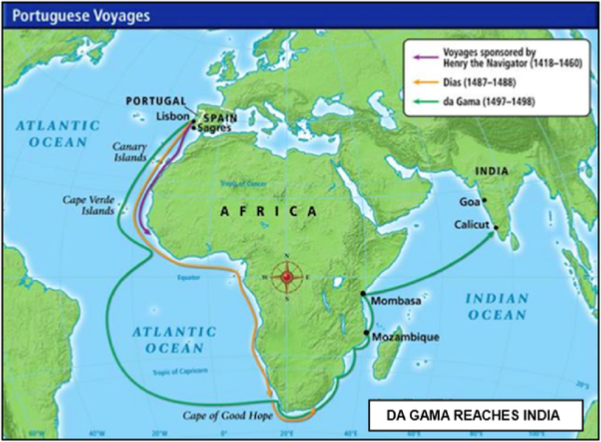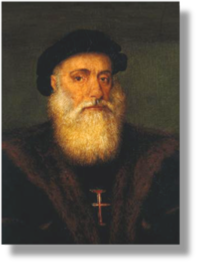


VASCO DA GAMA c1469 -
xxxxxAs we have seen, in 1488 the Portuguese  navigator Bartolomeu Diaz became the first European to lead an expedition around the Cape of Good Hope, and open the sea route to the Far East.
navigator Bartolomeu Diaz became the first European to lead an expedition around the Cape of Good Hope, and open the sea route to the Far East.
xxxxxThe man chosen to take advantage of this momentous discovery was his fellow countryman Vasco da Gama, a nobleman with experience as a soldier as well as a sailor. Appointed to command a voyage of exploration in July 1497, he stayed well out to sea until taking fresh water and provisions at the Cape Verde Islands. Then, keeping out of sight of land for 13 weeks, he reached St. Helena Bay on the west coast of South Africa before rounding the Cape of Good Hope, a stormy voyage of almost three weeks. He reached the east coast of Africa on Christmas Day, naming the area Natal, and then called in at Mombasa -
xxxxxFollowing  the success of this first voyage to India, a second expedition was launched in 1500, this time led by the navigator Pedro Cabral. It was he who, sailing too far west on leaving Lisbon reached India via Brazil and claimed this huge land for Portugal! On eventually reaching India, he established a trading post at Calicut on the west coast. It was during this expedition that Diaz was drowned during a storm off the Cape of Good Hope.
the success of this first voyage to India, a second expedition was launched in 1500, this time led by the navigator Pedro Cabral. It was he who, sailing too far west on leaving Lisbon reached India via Brazil and claimed this huge land for Portugal! On eventually reaching India, he established a trading post at Calicut on the west coast. It was during this expedition that Diaz was drowned during a storm off the Cape of Good Hope.
xxxxxIn 1502, following reports of the murder of a number of Portuguese in Calicut, Vasco da Gama led a punitive expedition to India and attacked and plundered the port. In the same year, he founded the Portuguese colony of Cochin on the Malabar coast and established a Portuguese presence in Mozambique along the south-
xxxxxThe voyages of  Vasco da Gama, together with those of his contemporaries, Diaz and Cabral, opened up a new chapter in world history, providing Western Europe with a sea route to the Far East which could be used for both trade and colonial expansion. Such lands as India, China and Indonesia (the Spice Islands) were now accessible by sea -
Vasco da Gama, together with those of his contemporaries, Diaz and Cabral, opened up a new chapter in world history, providing Western Europe with a sea route to the Far East which could be used for both trade and colonial expansion. Such lands as India, China and Indonesia (the Spice Islands) were now accessible by sea -
xxxxxIncidentally, in 1572  his fellow countryman, the poet and soldier Luis de Cameons, wrote his famous work Os Lusiadas, a long narrative poem based on Vasco da Gama's historical voyage to India. It was at once hailed as Portugal's national epic. ...…
his fellow countryman, the poet and soldier Luis de Cameons, wrote his famous work Os Lusiadas, a long narrative poem based on Vasco da Gama's historical voyage to India. It was at once hailed as Portugal's national epic. ...…
xxxxx...... During his voyage to India in 1498, Vasco da Gama took this statute of the Archangel San Raphael with him to ensure his safe return.
xxxxxAs we have seen, it was in 1488 that the Portuguese navigator Bartolomeu Diaz rounded the Cape of Good Hope. Ten years later his fellow countryman Vasco da Gama sailed further and reached India's Malabar coast in May 1498. Then, following an expedition to India by Pedro Cabral in 1500, Vasco da Gama made a second visit to the Far East two years later. He founded a trading station at Cochin and landed in Mozambique. Twenty years later he was appointed Portuguese viceroy, but died in Goa two months after his arrival. His discoveries, plus those of Diaz and Cabral, apart from giving Portugal a head-



Acknowledgements
Säo Gabriel: detail, watercolour by the Portuguese artist Ernesto Casanova (born 1845), illustration for the epic story of Os Lusidas by the Portuguese poet Luis de Camoens (1524-
H7-